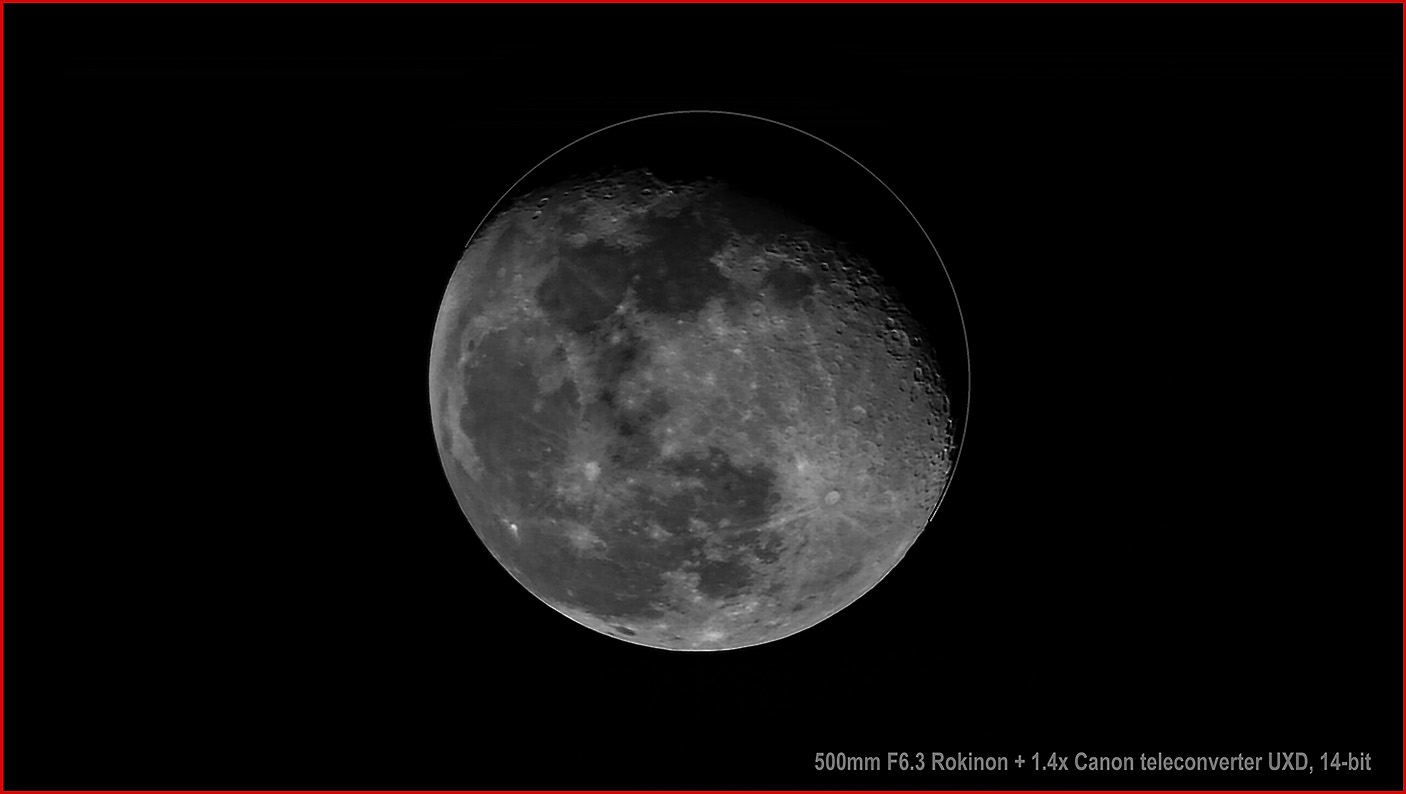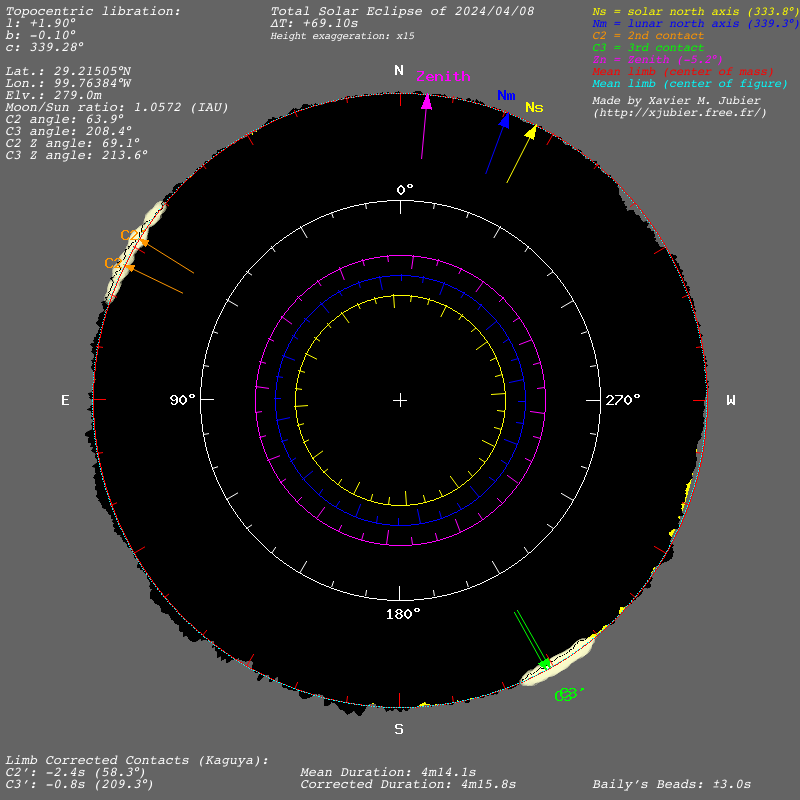Even More Eclipse Preparations
10/25/2023. Both powerbanks run the EOS-M solidly and take their sweet time draining from 100% to about 50-55%. And then they just die. So count on keeping them well charged for crucial events, and keep both handy. Carry some fully-charged regular Canon batteries, too, just to be sure, and to provide a workaround if for any reason the power cable flakes out.
The 500mm Rokinon + TC200 works beautifully on the R6 (which is a surprise), but that's a little too much image scale for the EOS-M. No matter what I do, the 300mm Nikkor just seems soft. This surprises me because it looked good in 2017 on the same camera body. I can sharpen it up by closing it down to F8 or so, and maybe even get a decent image with the TC-200, but that would be 600mm at F16 and that's just too dim. The 500mm works nicely by itself, and since it's clear that this one (which is neither rare nor expensive) performs, I may end up with two identical lenses working this eclipse. That just seems wrong somehow, but there it is. Make another belt driven focusing gearing mechanism to mount on the top handle of the EOS-M and its cage.
I can run 14-bits continuously, comfortably by backing off to UHD mode in 16:9 aspect ratio. So do that. And I've discovered that if you hunt long enough, you can find the option to adjust the spread of the dual ISO configuration. I'm experimenting with 200/1600 and 100/1600, the better to get Baily's beads and some of the inner corona with a video camera operating at F8 or so.
10/26/2023. The SD cards in the R6 are sometimes unrecognized. At least one of them suffers this ignominy every few days. I've used them constantly, sliding them in and out every several days for years. So I went looking for the best cards. And the best are clearly considerably faster, which will matter when shooting as rapidly as possible at 2nd and 3rd contact. Take that as your excuse to replace them sometime over the next few months (with enough time to develop confidence in them).
The Kingston Canvas React Plus UHS-II is one possibility, and so is a line of high-speed ruggedized Sony SD cards. The biggest advantages for my needs (apart from simply working!) are rapid buffer clearing and longer burst speeds. Think it through.
10/31/2023. The second 500mm F6.3 Rokinon lens is here from eBay and appears to be in great shape. It came with a Canon EF mount rather than the expected Nikon F mount. I put a 1.4x Canon extender behind it and an EOS-EFm adapter behind that. I cobbled up a timing belt focusing widget and did some slightly hasty tests. Slightly hasty in that focus was good but not perfect -- focus peaking said I was focused, and I almost was. Make the peaking criteria more demanding if possible, and pay obsessive attention to the half-press 10x focusing aid. The image cleaned up well with deconvolution just the same, so it was close. 1/640 @ ISO 200 was an OK exposure. Ten stops of additional exposure (1/24 at ISO 6400) did not show troubling glare. That's 1,000x more light. Here's the image scale of the 500mm + 1.4x converter on the EOS-M in UHD mode:

This combination works fine for video but balks at making still photos, throwing an error since the camera see's the Canon extender and does not get any feedback from the lens mounted on it. Just cover the contacts somewhere along the chain and all should work (done! see below).
Xavier Jubier's eclipse software does excellent maps and precise local circumstances including Baily's Beads calculations based on the lunar profile. Here's the prediction for Uvalde:

Yes, I did do a retrocast for 2017 as seen from the intersection of Nebo and Shoshone Roads out in the Wind River Basin east of Riverton. Spot on! In Uvalde, the second contact beads will be very local and protracted (2.4 seconds) while the third contact beads will be faster (0.8s) and rapidly spread north around the Moon. Second contact should actually be an excellent diamond ring; only a short arc of the chromosphere will appear at 2nd contact but it will be much better displayed at third contact.
11/02/2023. Some notes from another moonrise: the 14-bit UHD mode ended early when first initiated tonight, but it resumed at the next press of the button and ran well for several minutes on each start thereafter. It's the only such early termination I've seen in that mode. (1) Just before totality, run a 10s dummy clip just to get all the data pathways established. (2) When shooting Moonrises from the community lot, expect the Moon to rise 3-4 minutes late compared to a maritime time prediction, and expect it to rise about 1/2 degree farther south. This is for azimuths with a decently distant horizon (bearings of 55-65 degrees for example, over Granite Falls and out toward Barrett Ridge). (3) Blending two identical clips with a one frame delay at 50% removes a ton of noise. (4) An L-bracket attached to the EOS-M body solves the mounting issue discovered last night (the camera would have been at 90-degrees to its intended orientation). (5) It does not appear to me that focus peaking does any good with Moonrise. Try it with a solar filter and drop that setting if it's useless -- the red speckles scattered across the frame are distracting and using that feature must put at least a minor load on the camera's processor. (6) At 700mm and F9, the lights on the comm tower near the water treatment plant are just a little too close to use as focusing targets: dial them in and then cheat focus ever so slightly to the far side of them. (7) If you can think of a way to use a finder for this camera configuration, do it.
11/04/2023. I finally nailed the first spark of the rising Moon last night. I could hardly have missed: it was one field south of the cell tower and delayed about four minutes from maritime. I did not miss focus peaking at all. Tonight's quibble: 10x magnification was very difficult to use. It was too easy to full-press the shutter and too hard to hold halfway while also manipulating the focus knob. I've remapped the 10x magnification function from shutter half-press to the "Set" button.
Also, if I accidentally fully press the shutter button, the EOS-M throws an error message: something something electrical connection with the lens. Of course, there is no electrical connection with this full-manual lens, but because I'm using a modern tele-extender, the camera thinks there ought to be. I placed a strip of electrical tape over the contacts on the extender ahead of the adapter. Now the camera thinks of the Rokinon as a dumb lens, which it is, rather than as a misbehaving Canon lens, which it isn't. Win-win: it doesn't throw an error requiring clearing, and I can actually take a long exposure still. That sort of image might be nice in its own right, but it can also help to aim the camera when the scene is too dim for the video mode to reveal where it's pointed. [11/06. Yep. That works.]
Now, about solar filters. Both the R6 and the EOS-M are mirrorless cameras, so I can't leave them aimed at the un-eclipsed Sun for very long (think seconds before and after totality). That means both lenses will need filters for aiming. The filters must be securely attached (that Texas wind) and must also be easily removed (no jostling!). I've ordered a pair of 95-105mm step-up rings for the front of the dew shields with the notion that pins or screws can be inserted through them on which framed filters can be hung. I'm still thinking about this one. Consider a Texas two-step: frame, focus, shoot partial phases through filters; then a couple of minutes before totality, remove the filters in favor of a simple, loose cap, aluminum foil for example. Finally, uncover the lens within a few seconds of totality and start both cameras. Remember to aim away or re-cover immediately after 3rd contact.
11/05/2023. I tried it out on the filtered Sun using a temporary filter holder. The "Set" button for 10x magnification is much better than shutter half-press. In one clip today the 3x anamorphic stretch was not applied. If possible, detemine why and be sure that doesn't happen on The Day. Work up a shim or shims to keep the cage from shifting when the lens is focused using the timing belt. It takes very little slack to let a cropped 700mm lens wander off-target, and I've got the cage tightened down about as much as I wand to. There are available threaded holes which should make this easy-ish. [11/06. Easier still, the adjustment was part of the cage. I discovered this when I took it apart to work on shims.] And make a more secure receiver for the knurled knob that moves the belt. The threaded run that holds it in the prototype is much too short and allows the knob to wander [11/06: done!]
:: top ::